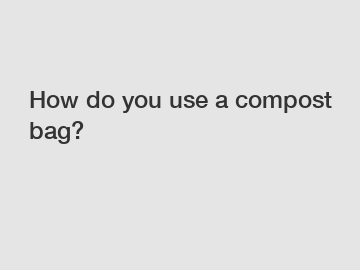How do you use a compost bag?
How Do You Use a Compost Bag?
Composting is a great way to reduce waste and create nutrient-rich soil for your garden. One essential item for successful composting is a compost bag. If you are new to composting or unsure about how to use a compost bag, this article will guide you through the process. From selecting the right bag to maintaining and emptying it, we will cover all the information you need to know.
Selecting the Right Compost Bag.

Choosing the right compost bag is important to ensure that your composting process is efficient and odor-free. Look for a bag made of breathable material that allows airflow, which is essential for the breakdown of organic matter. Avoid bags made of plastic or other non-permeable materials as they can retain moisture and create an unpleasant smell. Opt for bags specifically designed for composting, which are usually made from natural fibers such as jute or burlap.
Placing the Compost Bag.
Once you have selected the appropriate bag, find a suitable location for your compost pile. It is best to place the bag on a flat surface that is easily accessible. Make sure the area is well-drained to prevent waterlogging, which can hinder the composting process. Ideally, the site should receive partial sunlight to promote decomposition.
Filling the Compost Bag.
Now that you have the bag in the right spot, it's time to start filling it with organic waste. Begin by adding a layer of dry, brown materials like leaves, twigs, or shredded paper. This helps create airflow and provides carbon-rich material for the compost. Next, add a layer of green materials such as vegetable scraps, fruit peels, or grass clippings. Green materials are nitrogen-rich and provide the necessary nutrients for decomposition. Repeat these layers alternately until the bag is almost full. Remember to avoid adding meat, dairy products, or oily substances, as they can attract pests and slow down the composting process.
Maintaining the Compost Bag.
To ensure efficient decomposition, it is important to maintain the compost bag regularly. One key aspect is moisture levels. The compost should be moist, similar to a wrung-out sponge. If the bag appears too dry, add water using a watering can or hose. On the other hand, if it is too wet, add more dry materials to absorb the excess moisture. Additionally, mix the contents of the bag regularly using a pitchfork or garden fork. This helps aerate the compost and promotes even decomposition.
Emptying the Compost Bag.
After a few months, your compost should be ready to be utilized. It will have transformed into dark, crumbly soil-like material with a pleasant earthy smell. To empty the compost bag, simply open it and transfer the contents onto your garden beds, potted plants, or wherever you need nutrient-rich soil. If you encounter any undecomposed materials, such as large branches or stubborn clumps, you can either remove them manually or return them to the compost bin for further decomposition.
In conclusion, using a compost bag is a simple and effective way to create nutrient-rich soil for your garden. By selecting the right bag, placing it in an appropriate location, filling it with the proper ratio of brown and green materials, and maintaining it through regular watering and turning, you can produce high-quality compost. So why wait? Start your composting journey today and contribute to a healthier and more sustainable environment.
For any further questions or assistance with composting, please do not hesitate to contact us. We are here to help you make the most of your composting experience.
Are you interested in learning more about starch based biodegradable plastic bags, custom biodegradable bag Manufacturer, does resin biodegrade? Contact us today to secure an expert consultation!

Comments
0